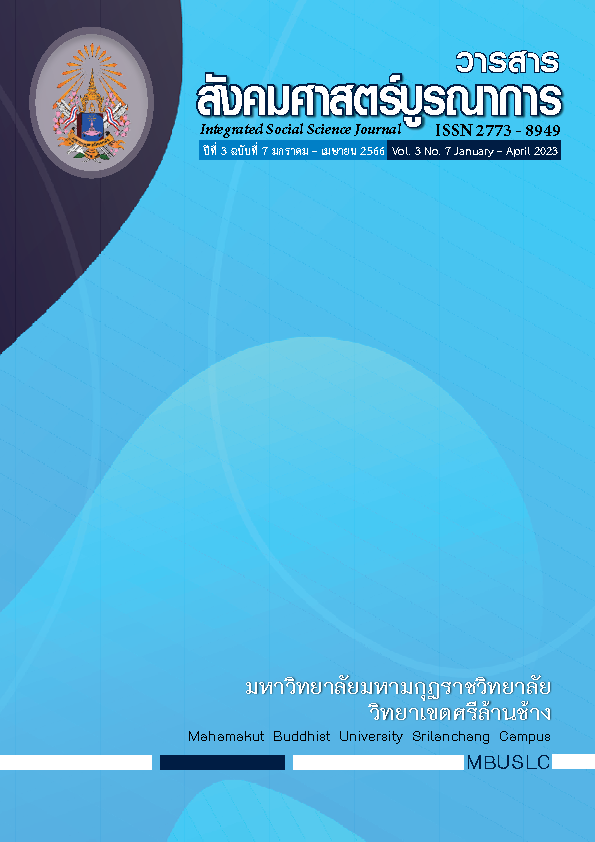LEARNING SPACE ENHANCEMENT OF MAHAMAKUT BUDDHIST UNIVERSITY, SRILANCHANG CAMPUS
Main Article Content
Abstract
This research aimed to (1) study the learning space of Mahamakut Buddhist University, Srilanchang Campus. (2) compared the learning space of of Mahamakut Buddhist University, Srilanchang Campus, classified by gender, student level, and major. The sample was 242 students of Mahamakut Buddhist University. The tool used in this process was a questionnaire with its reliability, analyzed by Cronbach’s Alpha coefficient, value of .88. The statistics used to analyzed the data were: frequency, percentage, mean, standard deviation, t-test, and One Way ANOVA.
The research result found that (1) the learning space of Mahamakut Buddhist University, Srilanchang Campus, in overall and each aspects were at the moderate level. (2) Comparing the learning space of Mahamakut Buddhist University, Srilanchang Campus, classified by gender, student level, and major, were found that there was not difference.
Article Details

This work is licensed under a Creative Commons Attribution-NonCommercial-NoDerivatives 4.0 International License.
บทความที่ได้รับการพิจารณาจากคณะกรรมการผู้ทรงคุณวุฒิและเผยแผ่ในวารสารฉบับนี้ เป็นทัศนคติและข้อคิดเห็นส่วนบุคคลของผู้เขียนแต่ละท่าน ไม่ถือว่าเป็นทัศนะคติและความรับผิดชอบ
ของบรรณาธิการ
บทความ ข้อมูล เนื้อหา รูปภาพ ฯลฯ ที่ได้รับการตีพิมพ์ในวารสารสังคมศาสตร์บูรณาการ ถือเป็นลิขสิทธิ์ของวารสารสังคมศาสตร์บูรณาการ หากบุคคลหรือหน่วยงานใดต้องการนำทั้งหมดหรือส่วนหนึ่งส่วนใดไปเผยแพร่ต่อหรือเพื่อกระทำการใด ๆ จะต้องได้รับอนุญาตเป็นลายลักอักษรจากวารสารสังคมศาสตร์บูรณาการ ก่อนเท่านั้น
References
จักรกฤษณ์ โพดาพล และสุพรรณี บุญหนัก. (2563). สถิติเพื่อการวิจัย และการใช้โปรแกรม SPSS ในการวิจัย. เลย: สำรวยก๊อปปี้ บ้านใหม่.
มานะ ครุธาโรจน์์. (2563). กลยุทธ์การพัฒนาสมรรถนะผู้บริหารสถานศึกษาขั้นพื้นฐานยุคการศึกษา 4.0. วารสารสังคมศาสตร์์และมานุษยวิทยาเชิงพุทธ, 5(9). หน้า 351-369.
วนิดา วาดีเจริญ, รังสรรค์ เลิศในสัตย์, และสมบัติ ทีฆทรัพย์. (2560). ระเบียบวิธีวิจัยจากแนวคิดทฤษฎีสู่ภาคปฏิบัติ. กรุงเทพฯ: บริษัท ซีเอ็ดยูเคชั่น จำกัด (มหาชน).
Brown, M. (2005). Learning spaces. In EDUCAUSE (Educating the net generation). Retrieved April 20, 2016, from https://net.educause.edu/ir/library/pdf/pub7101.pdf
Brown, M. & Long, P. (2006). Trends in learning space design. In D.G. Oblinger. EDUCAUSE. EDUCAUSE. (Learning spaces). pp.9.1-9.11Retrieved April 20, 2016, from https://net.educause. edu/ir/library/pdf/pub7101.pdf
Cornell, P. (2002). The impact of changes in teaching and learning on furniture and the learning environment. New directions for teaching and learning. 92, 33-41. San Francisco: Jossey-Bass.
Gee, L. (2006). Human-centered design guidelines. In D.G. Oblinger. EDUCAUSE (Learning spaces). pp. 10.1-10.13. Retrieved April 20, 2016, from https://net.educause. edu/ir/library/pdf/pub7101.pdf
Kneppell, M. & Riddle, M. (2012). Distributed learning spaces: Physical, blended and virtual learning spaces in higher education. In M.Keppell, K, Souter, & M. Riddle. Physical and virtual learning spaces in higher education: Concepts for the modern learning environment. (pp.1-21). PA: Information Science Reference.
Krejecie, R. V., & Morgan, D. W. (1970). Determining sample size for research activities. Educational and Psychological Measurement, 30, 607-610.

